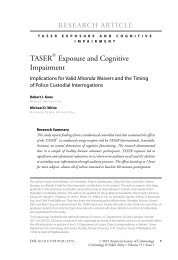1qaSADJ
1qaSADJ
1qaSADJ
Create successful ePaper yourself
Turn your PDF publications into a flip-book with our unique Google optimized e-Paper software.
Special Focus:<br />
Writing Persuasively<br />
Arguments of fact state that something is or is not the case. Causal arguments say that<br />
one event or condition leads to another or is likely to. For example, we might argue that<br />
AP students do better in college, that computers enhance learning in the classroom, that<br />
the media is responsible for the shortening of the attention span, or that mercury in the<br />
food chain or cigarette smoke in the air causes cancer.<br />
Arguments of value state that something is or is not desirable. They involve evaluations<br />
of quality or worth according to accepted criteria. For example, one might assert that this<br />
or that novel or film is of significant merit, that preemptive war is or is not a justifiable<br />
practice, that Bill Clinton was or was not a good president, that health concerns take<br />
precedence over profit.<br />
Arguments of policy state that something should or should not be done. They make<br />
recommendations for practice or implementation. For example, that the minimum wage<br />
should be increased, that stem cell research should be funded, that Huck Finn should<br />
or should not be part of the curriculum, that gay marriage should or should not be<br />
legalized, that more students should have access to AP, that the designated hitter should<br />
be eliminated from baseball (one of the finest arguments I saw at the 2004 AP English<br />
Language Reading, by the way), or that smoking should be banned from public places.<br />
This kind of argument will naturally contain components—often included as support—of<br />
those of fact and value, as my final example in each category illustrates.<br />
The Toulmin Model<br />
Because the Toulmin model for argument analysis is widely recognized for its utility as an<br />
analytical tool, it might seem more applicable as a reading than a writing heuristic, since<br />
it enables students to understand the nature of sophisticated arguments that they read<br />
on account of the logical process it prescribes. But because of that new knowledge, it also<br />
serves in the teaching of composition, since students can apply knowledge from one area<br />
to another. The model is at work in this paragraph and in the first sentence of this article,<br />
as we will see. Its components are as follows:<br />
A claim is an assertion. It should seem a “conclusion whose merits we are seeking to<br />
establish,” in Toulmin’s words, or “the conclusion you reach after testing the evidence that<br />
supports your belief,” as Kathleen Bell puts it in Developing Arguments.<br />
The support consists of the data used as evidence, reasons, or grounds for the claim.<br />
A warrant expresses the assumption necessarily shared by the speaker and the audience.<br />
24<br />
AP® English Language and Composition: 2006–2007 Workshop Materials



